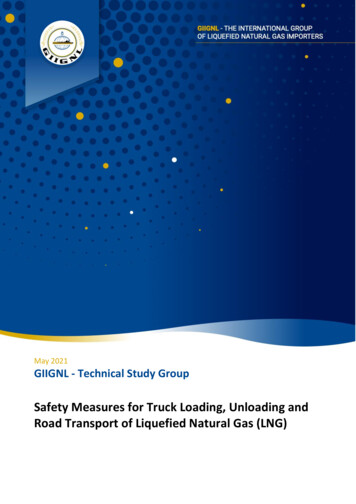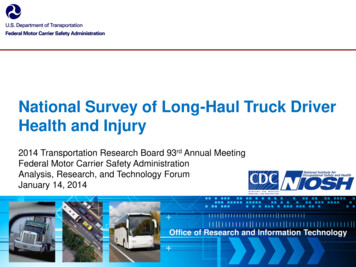
Transcription
May 2021GIIGNL - Technical Study GroupSafety Measures for Truck Loading, Unloading andRoad Transport of Liquefied Natural Gas (LNG)
Content DisclaimerThe purpose of this document is to propose a set of safety recommendations related to loading /unloading and transport of LNG by road tankers, subject to the consideration of International Group ofLiquefied Natural Gas Importers (GIIGNL) members. These recommendations shall not be considered astandard nor a specification and should only be viewed as a summary of the best practices used withinthe industry. No specific procedure, nor particular manufacturer of equipment, is recommended orimplied suitable for any specific purpose in this document. Readers should ensure that they are inpossession of the latest information, standards and specifications for any procedures and equipment theyintend to employ. Although GIIGNL has attempted to use the most up to date and accurate informationavailable, GIIGNL shall not be held responsible for the adequacy, accuracy, completeness, or correctnessof such information. GIIGNL including its members, disclaim any direct or indirect liability as to theinformation contained in this document for any industrial, commercial, or other use whatsoever.May 2021 – Technical Study GroupSafety Measures for Truck Loading, Unloading and Road Transport of LNG2
Contents1.INTRODUCTION. 41.1.1.2.BACKGROUND . 4PURPOSE AND SCOPE OF THE DOCUMENT . 42.PRINCIPAL RECOMMENDATIONS . 43.SPECIFIC MEASURES . 51.2.3.4.5.TECHNICAL MEASURES FOR LNG ROAD TANKER DESIGN . 5TECHNICAL MEASURES FOR THE DESIGN OF LOADING / UNLOADING FACILITIES . 6GENERAL ORGANISATIONAL MEASURES . 8MEASURES SPECIFIC TO HANDLING OPERATIONS (LOADING OR UNLOADING) . 9FEEDBACK FROM OPERATIONAL EXPERIENCE . 10Truck loading at Montoir-de-Bretagne LNG terminal - Credit: Elengy/Cyrille DupontMay 2021 – Technical Study GroupSafety Measures for Truck Loading, Unloading and Road Transport of LNG3
1. Introduction1.1.BackgroundTo meet the growing demand of the liquefied natural gas (LNG) and gas market, an increasing number of LNGimportation terminals offer truck loading services to deliver LNG to remote areas via road tankers. Manycountries have decided to implement these services as a cost-effective solution to supply customers whowant to access natural gas supplies, but for whom connecting to the gas grid is not economically feasible, orwho cannot wait until adequate pipeline infrastructure is developed. For industrial sites located far from thetransportation or distribution networks and for the mobility market, LNG as a fuel has become a viablealternative to conventual fuels due to the reduced CO2 emissions, particles and pollutant gases (NOx andSOx). LNG is also transported via road tankers to supply small power plants or for peak shaving needs. Hence,distribution of LNG via road tankers is set to continue to increase globally as a workable solution to deliverenergy to remote areas as well as a means of encouraging the development of new markets.The growing number of loading and unloading locations as well as the number of tankers on the roadsincreases the probability for an incident to occur. Most of the latest incidents that have occurred havefortunately had no, or very limited human and material consequences. However, a few of these near misseshad the potential to cause catastrophic losses.The key learnings from industry related incidents have been observed to be: Raising awareness of the hazards LNG poses to operational personnel, Emergency Response Services(e.g., firefighters) and the wider community as a whole. Preparing appropriate emergency response plans that are frequently exercised. Following appropriate operating procedures. Using personal protective equipment (PPE) that is appropriate for the hazards. Installing safety barriers that provide plant and personnel segregation on fixed and mobile facilities.1.2.Purpose and scope of the documentThe purpose of this document is to provide a panel of measures for consideration that operators undertakingLNG loading / unloading operations and transportation, can look to implement where possible.These measures are based on operational experience and the lessons learnt from previous incidents thatoccurred within the industry.2. Principal RecommendationsPrinciple recommendations related to the design, construction and operation of the LNG road tanker loading/ unloading facilities should be applied. Some of the key recommendations are as follows. Application of the regulations, in particular:May 2021 – Technical Study GroupSafety Measures for Truck Loading, Unloading and Road Transport of LNG4
oTraffic laws, such as the total weight allowed, speed limits, mandatory breaktime forpersonnel and other road safety guidelines.oThe ADR agreement1 or equivalent depending on the region.oThe Standards and Codes / Permits requirements related to the design, construction andoperation of the road tankers and LNG facilities. Application of policies and procedures related to LNG road tanker loading / unloading facilities. Appropriate operations, maintenance and inspection of the facilities and equipment.3. Specific MeasuresWhat follows is a set of specific measures that have the aim of informing operational personnel as to goodpractices for LNG road tanker operations. The following measures are divided into five categories:1. Technical measures for LNG road tanker design,2. Technical measures for the design of loading / unloading facilities,3. General organisational measures,4. Measures specific to handling operations (loading or unloading),5. Feedback from experience.1. Technical measures for LNG road tanker designMeasuresMain Objective / Risk AddressedUse of a double-walled vacuum-insulated Enhanced structural integrity and hence a lowertankers (when not mandatory).likelihood of a breach of containment followingan external impact.Improved insulation, thus reducing heat flowinto the stored LNG within the tanker.Equipping the road tanker with an emergencyshutdown (ESD) system that closes isolationvalves and shuts down the LNG transferpump(s) (when applicable).The operator can initiate an ESD of the roadtanker loading / unloading operation during anemergency event, thus minimizing the risk ofescalation of the incident.Coupling of the road tankers ESD system to the Enabling the road tanker to connect to the sitessites air supply.instrumentation air system for enhanced ESDresponse.1European Agreement concerning the International Carriage of Dangerous Goods by Road / Accord européen relatif au transport internationaldes marchandises dangereuses par route.May 2021 – Technical Study GroupSafety Measures for Truck Loading, Unloading and Road Transport of LNG5
Use of isolation valves for liquid and gas lines on Reducing the likelihood of failure for the criticalthe road tanker which are controlled by fail-safe safety valves due to loss of the actuator driveactuators and an excess flow valve (EFV) on the source.liquid line.Upon loading line failure, the EFVs willautomatically close, minimizing the loss ofcontainment.Use of an inhibit system which maintains theclosure of the product transfer lines when theroad tanker brakes are not applied.Additionally, a safety system could be used tokeep the brakes applied when the truck cabin isopen.Reducing the likelihood of a rollaway event andhence preventing loss of containment due tofailure of a transfer line during if the road tankermoves off stand.Equipping the road tanker transfer control The operator must be present during thesystem with a "deadman button”.transfer process and press the deadman buttonat regular intervals. Without responding in time,the LNG transfer will cease.When not undertaking tasks, the operatorshould stay outside the hazardous area.Installing temperature sensors on the cold vent This feature notifies and hence minimises theline of the road tanker, which can activate an accidental discharge of LNG through the coldalarm to the operators.vent line.Establishing an identification system for theroad tankers and the drivers which have beenauthorised to enter the site (for example basedon a radio frequency identification (RFID tag).Only registered road tankers and associateddrivers can access the loading / unloading site.The characteristics of the road tankers, inparticular the maximum transportable quantity,should be registered in a database.2. Technical measures for the design of loading / unloading facilitiesMeasuresMain Objective / Risk AddressedInstalling entry / exit roadway barriers and Controlling the vehicle movements andvehicle impact protection around plant and reducing the risk of damage to the plant fromequipment.vehicle impacts.Installing gas, flame and cold detectors on the Automatic activation of the ESD system whichtruck loading / unloading bays which have an ceases the LNG and vapour transfer operationsexecutive ESD action. Best practice would be to and closes the isolation valves.install an array of detectors which have ESDactivation based on a voting system.May 2021 – Technical Study GroupSafety Measures for Truck Loading, Unloading and Road Transport of LNG6
Providing clearly marked and suitable quantities Providing appropriate mobile firefightingof dry chemical powder extinguishers available equipment will enable a plausible emergencythroughout the facilities.response in the first instance to a fire event.Installing low temperature sensors on the This recommendation is for the benefit ofvapour transfer lines.detecting the flow of LNG to the vapour transferlines (i.e., for example due to incorrect line outto the road tanker).Installing a vehicle / site control system linkwhich enables the activation of the tanker ESDfrom the site control system (i.e., bi-directionalESD system activated either from the roadtanker through the ESD pushbuttons or the site,for example during gas detection).Automatic shutdown of the loading / unloadingoperation in case of fire, gas or leak detection atthe station. The remote activation feature isbeneficial as the operator may not be able toaccess the local (tanker) ESD activation buttonsduring an emergency event.The instrumented loop should be fast actingfrom detection to final element actuation.Installing a break-away coupling on the LNGtransfer lines, which automatically and withoutdelay closes internal isolation valves in case oftension on the transfer line (hose).Reducing the likelihood of a breach ofcontainment due to the road tanker movingaway from the stand whilst the transfer processis occurring.Nota: Mainly useful when the cabinet is notequipped with a safety system which keeps thebrakes applied when it is open.Equipping each loading bay with a weight bridgeand / or a flow rate meter that is linked to thetanker filling controller which programmed withthe fill quantity of the tankers.The use of an automated filling systemcombined with a manual check (which is notnecessarily reliable) adds an additional layer ofprotection against overfilling of the roadtankers.Defining and maintaining hazardous area Ensuring electrical equipment and otherclassifications which are also marked within the operational activities are appropriatelyplant area.controlled as per the hazardous areaclassification.The road tanker loading / unloading bay shouldincorporate the use of an impounding basin forchannelling LNG spills away from the plant. Theimpounding basin should be designed toaccommodate the full volume of a road tanker.The impounding basin should be covered withlow thermal conductivity concrete and foamThe impounding basin is a means of channellingLNG leaks to a safe location that is away fromthe plant. The impounding basin will then allowfor the controlled vaporisation of the LNG.Preventing the build-up of LNG spillsunderneath road tankers reduces the risk ofboiling liquid expanding vapour explosions(BLEVE) and other hazardous pool fire events.May 2021 – Technical Study GroupSafety Measures for Truck Loading, Unloading and Road Transport of LNG7
glass blocks can also be installed at the bottom The installation of gas detectors with anof the basin.associated alarm provides a warning systemthat an LNG leak has occurred.Gas detectors can also be installed at theimpounding basin to provide either anotification to the operators or an automaticactivation of the firefighting systems (drychemical powder and foam systems).Additionally, having the drainage sump of the It is important that the drainage basins areimpounding basin equipped with a rainwater maintained free from standing water to ensurepump, which should shutdown upon the the catchment volume is kept available.detection of LNG (via gas detection or lowtemperature detection or other type of device).3. General organisational measuresMeasuresMain Objective / Risk AddressedDevelop emergency plans for the loading /unloading site. The muster points should takeinto account the different incident scenariosthat are likely to occur.To provide clear emergency instructions thatexplain the steps to be taken during anemergency event, with focus on protectingpersonnel and minimising impact on plant andequipment.Regular training of operators who engage in theloading / unloading activities. Focus should beapplied to the hazards associated with LNG andgas and the control measured required to beimplemented.The on-going training raises and maintainsawareness of operators and develops a safetyculture within the organisation to continuallystrive to improve safety performance.It is recommended that road tanker drivers arerequested to demonstrate that that they haveundergone initial training and are takingrefresher courses specific to the handling ofLNG. The training should address the followingtopics:These steps ensure that the road tanker drivershave acquired the competencies andexperience to perform the tasks required fromthem. Properties of LNG and gas and theassociated hazardsLoading / unloading procedures (withillustrations of the different steps)Road transport of hazardous goodsEmergency proceduresMay 2021 – Technical Study GroupSafety Measures for Truck Loading, Unloading and Road Transport of LNG8
Establishing an approval procedure to access It is important that the road tanker compliesthe loading / unloading sites, which should with the regulations and is fully compatible incomprise of:terms of access and connections. Checking of mandatory and requireddocuments (license of the driver, ADRpermit, vehicle registration and number ofslot reservation)Compatibility analysis of the road tankerwith the loading facilitiesConducting a test loading / unloading todemonstrate the competencies of thedriver (operator) and their familiarity withthe equipment and the proceduresThe driver (operator) should demonstrate theirability to perform the operation.It is recommended that the driver keeps the These steps enable the driver (or otherfollowing information readily available interested party) to readily refer to the(preferably stored inside the truck’s cab):important documents as to the nature of thecargo and the safety procedures required. the loading and unloading procedures forthe tanker the tanker’s P&IDs2 or engineering line In particular the safety data sheet is useful fordiagrams, which should be displayed in the the fire brigade in case of a road traffic incident.valve box the emergency procedures the safety data sheet for LNGIt is recommended that strict site accesscontrols are implemented, and only approvedroad tankers and drivers be able to access thesite.Due to the nature of road tanker operations, itis expected that large numbers of tankers andhence drivers will attend the site each day. It isimperative that the access control measures besuitable to adequately verify the tankers andthe drivers whilst maintaining a high level ofsecurity at all times.4. Measures specific to handling operations (loading or unloading)MeasureMain Objective / Risk AddressedIt is recommended that operators wear the PPE provides an important final safety barrier toappropriate PPE for the task:protect personnel carrying out the handlingoperations. Helmet equipped with a face screen and achinstrap2Piping & Instrumentation DiagramMay 2021 – Technical Study GroupSafety Measures for Truck Loading, Unloading and Road Transport of LNG9
Antistatic, flame resistance and high Reducing the risk of ignition sources from staticenergy.visibility clothingAntistatic safety shoes with toe protectionCryogenic protective glovesHearing protectionsOperators should also use LNG specific andapproved tools. The utilization of makeshifttools is strictly prohibitedThe following measures should also beapplied: Once on the stand, the LNG road tankerengine should be switched off and the keysshould be stored in a designated place.The road tanker parking brake should beapplied, and a wheel chock should beinserted to reduce the risk of rollaway.A positive earthing system with anassociated inhibit should be used to preventthe start of the transfer operation if thetanker is not correctly earthed.Removing potential sources of ignitionwithin the hazardous area of the loading /unloading baysThe road tanker transfer ESD system shouldbe routinely tested. Where possible the ESDsystem could be tested prior tocommencing an LNG transfer operation.Reducing the risk of transfer hose / arm rupturedue to tanker rollaway.All safety instrumented loops should beidentified and routinely tested. Testing shouldinclude the sensing and actuating elements.Each driver should be equipped with a Detection of small leaks as the gas is odourlesscalibrated portable gas detector and a portable and colourless.flashlight rated for the electrical hazardous areaclassification.5. Feedback from operational experienceRecommendationMain Objective / Risk AddressedAnalysis the incidents and near misses that Identifying the root causes and learning fromoccurred during loading / unloading operations the incidents is paramount to adapting theand during the road transport of the cargo.safety practices and systems to be as safe aspossible.May 2021 – Technical Study GroupSafety Measures for Truck Loading, Unloading and Road Transport of LNG10
Collecting data from incidents, near misses anddangerous situations and reporting the findingsto the relevant professional organizations.Publishing summaries (anonymously ifrequired) and providing analyses of theseevents on a regular basis.May 2021 – Technical Study GroupSafety Measures for Truck Loading, Unloading and Road Transport of LNG11
ContactAuthor:GIIGNL Technical Study GroupEmail:central-office@giignl.orgPhone: 33 1 84 78 47 15Website: https://giignl.orgMay 2021 – Technical Study GroupSafety Measures for Truck Loading, Unloading and Road Transport of LNG12
Truck loading at Montoir-de-Bretagne LNG terminal - Credit: Elengy/Cyrille_Dupont . May 2021 - Technical Study Group Safety Measures for Truck Loading, Unloading and Road Transport of LNG 4 1. Introduction 1.1. Background To meet the growing demand of the liquefied natural gas (LNG) and gas market, an increasing number of LNG importation terminals offer truck loading services to deliver LNG .










